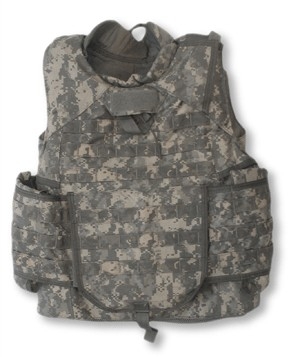
How does body armor work? By breaking up the bullet and removing its kinetic energy.
Armor has been around for a long time, but it has always had to adapt to the technology of weapons. In the Bronze Age, they had bronze armor because it was enough to stop a bronze sword blade. Then the Iron Age came along, and bronze armor won’t stop an iron sword blade, so armor had to adapt. By the 14th century, crossbows have become much more powerful and small canons have been introduced onto the battlefield. This meant that armor had to become thicker and heavier. Then guns were invented. They weren’t very powerful in the early days and a good thick suit of armor would stop pretty much any bullet that wasn’t fired from close range. Then a mini arms race started. Armor was made musketproof with thicker plates, and shapes that caused the musketball to ricochet off, but muskets also became more powerful, until they reached the point where the musketball would penetrate the armor. And now, no medieval suit of armor would be able to stop a bullet fired from a gun.
So, how does body armor work? There are two types of body armor that are designed to stop bullets: hard armor and soft armor.
Soft body armor works by stopping a bullet in an extremely strong net. The body armor has a mesh of fibers inside it that are made into sheets. These fibers are twisted for strength and woven vertically and horizontally across each other to make a net. Layers of these fibers are laid on top of each other and then fixed into the jacket. When the bullet hits the net, it pushes back on the net, but the fibers are too strong and they arrest the bullet while spreading its energy out across the whole surface of the sheet. This happens because when the bullet is caught, it pulls on the fibers it is touching, and these fibers pull on all the other fibers they are entwined with, and this spreads out the energy. The person being shot will still feel the impact of the bullet, but it will be spread out all over the body armor. It would be akin to having a 40 kg mattress dropped on you or having a 40 kg person stop on you with all their weight on a single stiletto.
Kevlar is often used in soft body armor. Kevlar was discovered by accident in 1965. Kevlar is a synthetic fiber that is five times stronger than steel. It is also much lighter than hard body armor, making it very popular for the police. It doesn’t have the protection of hard body armor, but it is useful against smaller hand guns.
Hard body armor gives more protection that soft body armor, but it is much heavier and makes movement more difficult. The idea behind hard body armor is the same as with the suit of armor. The vest is lined with plates of a material that are hard enough to stop the bullets. Bullets travel at over 800 meters per second, so not any material will stop them. A thick plate of steel will stop a bullet, but it is very heavy. Ceramics are a much better option. The ceramic used in body armor is boron carbide. Boron carbide is the third hardest substance in the world, after diamond and cubic boron nitride. However, boron carbide is only really effective with bullets travelling below 900 meters per second. When a bullet travels faster than that, the energy on impact causes the boron carbide’s internal structure to change from the ultra-hard crystalline structure to a more haphazard glass-like structure. This means, faster bullets will cause cracks in the ceramic, and it could fail. The boron can be made stronger and more resilient by adding silicone to it.
The best type of body armor combines hard and soft technology. Ceramic plates on top of a Kevlar base can provide a lot of protection. The problem is, the more protection that is added, the heavier the body armor will become. This can be seen in tanks as well. The more armor the tank has, the heavier and more unwieldy it is.
The weight of the body armor is the reason that a lot of research is being put into developing stronger and lighter synthetic materials at the moment. Vectran is one. It is a synthetic fiber that is 2 times stronger than Kevlar and 10 times stronger than steel. Then there is biosteel, which is made from a protein similar to spider silk and it is 20 times stronger than steel. And finally, there is graphene, which is still too expensive to produce, but which is 200 times stronger than steel and incredibly light. At some point in the future, we will be able to have body armor that looks no different to a normal shirt. And this is what I learned today.
Sources
https://www.sciencedirect.com/topics/engineering/body-armour
https://science.howstuffworks.com/body-armor.htm
https://www.spartanarmorsystems.com/blog/how-body-armor-works-a-technical-look/
https://en.wikipedia.org/wiki/Body_armor
https://en.wikipedia.org/wiki/Bulletproof_vest
https://www.wonderopolis.org/wonder/how-fast-can-a-bullet-travel
https://spectrumnews1.com/ca/la-west/news/2020/03/10/how-does-a-bullet-proof-vest-work-
